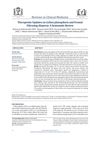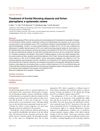Frontal Fibrosing Alopecia: Efficacy of Treatment Modalities
April 2019
in “
DOAJ (DOAJ: Directory of Open Access Journals)
”
TLDR 5-α-reductase inhibitors, intralesional steroids, and hydroxychloroquine are the most effective treatments for frontal fibrosing alopecia.
Frontal fibrosing alopecia (FFA) was a challenging condition to treat, primarily affecting postmenopausal women and characterized by a receding frontotemporal hairline and eyebrow loss. The goal of treatment was disease stabilization rather than hair regrowth due to its scarring nature. At the time, there were no randomized controlled trials evaluating treatment efficacy, and knowledge was based on small retrospective studies. The review highlighted various treatment options, including 5-α-reductase inhibitors, intralesional steroids, and hydroxychloroquine, which had the highest level of evidence for treating FFA. Other therapies, such as topical steroids, calcineurin inhibitors, systemic retinoids, pioglitazone, oral antibiotics, minoxidil, excimer laser, and hair transplantation, showed variable results and required further data for definitive conclusions.






